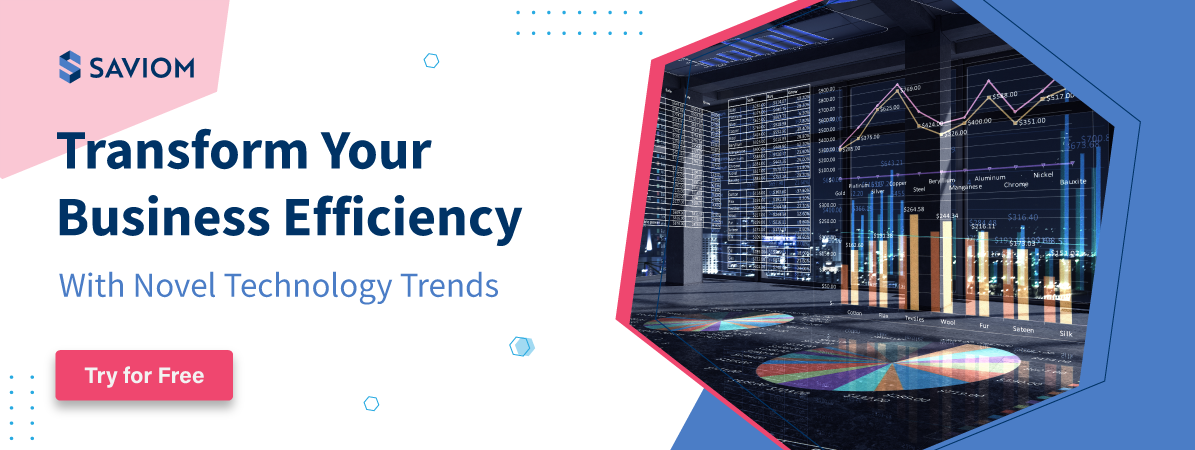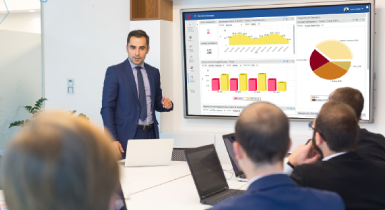“There is no alternative to digital transformation. Visionary companies will carve out new strategic options for themselves- those who don’t adapt will fail.”- Jeff Bezos, founder of Amazon.
It was rightly said by a business magnate who transformed the whole e-commerce industry. His courage to make bold moves and walk along with the novel technology trends made him the richest man globally. This is just one example of how technology has reinvented and uplifted the business landscape. Multiple instances are living proofs of the wonders of advanced tech trends.
The question is, are all these trends capable of giving businesses a competitive advantage? Is every technology worthy of massive amounts of investment?
To address these queries, we have compiled a list of trends that serve as the backbone of business innovation and transformation.
If implemented correctly, these novelties can enhance your organizational efficiency, improve employee experience, and help you explore the untapped areas of the business industry like never before.
This article illustrates the individual implications and combinatorial effects of these trending technologies on various business domains. So, are you ready to take a deep dive into this futuristic tech-driven world?
 Let’s begin with understanding,
Let’s begin with understanding,
What is the rate of technology change?
According to CompTIA, the global technology industry is forecast to reach $5 trillion in 2021.
This statistic is clear evidence of the escalating rate of adoption of technology. From the development of smartphones to advanced quantum computing, this era has witnessed a plethora of innovations.
A typical law is implemented to support this argument, known as Moore’s law. It states that the power of computing will double every 18 to 24 months. Undoubtedly, the computing systems have improved incrementally over the years, and the speed has increased from milliseconds to nanoseconds. In addition, it has opened doors for better connectivity, functioning, and so on.
However, it became increasingly challenging to align development speed with Moore’s law as the decades went by. Hence, it’s obsolete today.
Comparing the technological change to adoption rates, in 2000, Gartner had predicted that biometrics, quantum computing, etc., were poised to take off. But even two decades later, none of these technologies are in widespread acceptance and use yet.
On the other hand, America saw a massive transformation in the early 1900s, with rapid urbanization. For example, a stat revealed that just 2.3 million electrical household appliances were produced in 1900, but 84 million in 1919.
Overall, looking back at history, technology’s development and adoption rates haven’t been faster than in previous epochs. However, that’s not to say that we are not experiencing change; the pace could be better.

Let’s now look at the trends that have the potential to drive this technological transformation at an accelerated speed,
What are the technology trends that will reinvent the business infrastructure?
The business landscape has experienced a paradigm shift in the organizational skeleton, work culture, job market, etc. Most of these shifts were propelled by technology. For instance, limitless connectivity enabled globalization and a remote work model. Similarly, when combined, tech advancements like AI, Machine Learning, Automation, and so on can bring about a wave of reinvention with them.
Below is the list of most prominent trends that have the potential to change the business realm:
Internet of Behaviors to enhance employee satisfaction
Bringing a personalized touch to algorithmic technology is the new aim for tech avantgardes. The novel technology Internet of Behaviors (IoB) takes them nearer to their goal. It is an extension of IoT (Internet of Things) and an amalgamation of three major fields: Technology, Data analytics, and Behavioral Science.
Out of these, behavioral science can be further categorized into four areas, namely, emotions, decisions, augmentations, and companionship. Technology can tap into these four areas and sense the user’s reactions in different circumstances.
For example, behavior scientists can analyze customers’ behavior from the data procured from multiple sources like social media handles, wearables, and other IoT devices. This will allow the brands to understand the gaps and improve consumer’s experience. Furthermore, as psychology plays an instrumental role in marketing, IoB can work wonders for businesses looking to expand their reach.
At the same time, IoB can also be used at workplaces to enhance employee satisfaction. For instance, managers can evaluate employees’ behavior by amassing data from IoT and other devices and then implementing the right action course.
As Gartner says, IoB captures the digital dust of people’s lives.
Applied AI to improve customer experience
We all have witnessed the transition of searching for products from text to speech to images on e-commerce platforms. Needless to say, it has made shopping on online websites simpler and convenient. This change is attributed to Artificial Intelligence and its ability to train machines to recognize and interpret patterns and act on the same by making sense of the real-world data using computer algorithms.
AI implements three major technologies viz., Natural language processing (NLP), Computer Vision, and Speech technology. NLP creates a seamless experience for customers by allowing the technology to understand the human language easily. The prime example here is Chatbots. Consumers can resolve their issues faster using Chatbots rather than waiting in the queue on customer service calls.
Computer vision uses Machine Learning to make sense of visual data depicted in images or PDFs, etc. Lastly, Speech technology responds to the human voice, making Google Home, Alexa, or Siri a go-to encyclopedia. These technologies, when put together on one platform, can elevate the customer experience tremendously.
Next-gen connectivity with IoT and 5G
5G is known to increase the internet speed 100 times faster than 4G/LTE and reduce the latency from 20 milliseconds to less than one millisecond. Here, latency implies the time taken to retrieve data. On the other hand, the Internet of things comprises sensors, software, and other tech embedded in everyday objects like wearables, smartphones, etc. These sensors then receive and send the data to the end-users.
When combined, 5G and IoT can bring massive shifts in the business landscape. 5G enables faster connectivity across longer distances with a reduced latency period than ever.
One of the best-suited implementations of these tech advancements is in the manufacturing sector. It can be digitized and provide wireless control and monitoring of devices and machines. The supervisors can then retrieve data at a faster rate, track the progress, and deploy remedial measures in advance.
At the same time, with remote work being the new normal globally, the next-gen connectivity will make the business operations faster and facilitate quick decision-making. For instance, a manager can monitor an IoT connected workspace from a different location and instantly assess the environment, employee behavior, etc. This will fasten their decision-making ability and enhance their functioning.
Quantum and Neuromorphic computing solving unprecedented issues
The previous generation of AI-enabled computing was rule-based and was limited to concluding a narrowly defined problem domain. The current generation evolved and upgraded to sense and perceive using the deep learning networks that analyzed the content of video frames. The next-gen computing that will disrupt the market is neuromorphic computing that corresponds to human cognition.
It will emulate the neural structure and functioning of the human brain using the computational building blocks known as Spiking neural networks (SNNs). Neuromorphic computing is projected to find answers to questions that have bewildered science and society for years.
For example, one of the industries that can benefit from neuromorphic computing is pharmaceuticals. It will minimize the development time for chemicals by providing quick simulations and solutions. Neuro-based computing will also give an extra edge to adaptive robotics as the robots will perceive and respond to the stimuli on their own.
Talking about quantum computing, which uses quantum mechanics to solve complex issues more efficiently. It is still in its nascent stage, but when it reaches a certain maturity level, it will combat challenges that were previously impossible to cater to. Areas like transportation, traffic regulation, and energy storage will be majorly benefitted by quantum computing.
Hyper automation and virtualization to streamline mundane tasks
Hyper-automation and virtualization exhibit the combinatorial power of technology where robotics, the industrial internet of things (IIoT), digital twins, and 3D- or 4D- manufacturing are combined to automate routine (mundane) tasks and improve operational efficiency.
Previously, the processes and functioning of businesses were hampered due to the ‘organizational debt.’ Here, corporate debt is the interest that the company pays when its policies, talent, architecture, and processes remain stagnant when the world is changing. This had a negative impact on the value proposition and brand reputation.
Business leaders are clamoring to adopt digital operational excellence by integrating automation into the tech infrastructure to combat this shortcoming. Adding onto this is the emergence of remote work culture that has fast-tracked hyper-automation and virtualization into the business landscape. While hyper-automation can digitize documentation and process workflows, virtualization will make design and product development a breeze by allowing visualized simulations of prototypes.
A hybrid infrastructure to facilitate remote work (edge and cloud computing)
Conventional computing practices included on-premise IT-infrastructures that were time-consuming and demanded IT professionals to ensure data availability across all the offices instead of focusing on software development and innovation. However, the advent of cloud and edge computing has led to IT democratization. This has shifted the competitive advantage from IT to human-specific innovative skills.
Cloud computing provides ready-to-use vendor-supervised services to the end-users, whereas edge computing allows companies to procure and analyze their data. This eliminates the need to send the data to the centralized data hub and tremendously increases speed and reduces latency.
The ongoing remote work model can significantly benefit from the hybrid model of cloud and edge computing. It facilitates companies to control and retrieve their data on-demand from anywhere across the globe. It eventually helps them boost their speed, minimize complexities, strengthens data-driven decision-making and cybersecurity defenses. A hybrid computing model can be implemented in various industries, including utilities, education, manufacturing, etc.
Real-life implementation:
In 2018, it took the Broad Institute of MIT and Harvard eight minutes to sequence a human genome (at the rate of 16 terabytes per day). Since then, cloud-based analytics has lowered sequencing time by 400 percent.
Diversity, Equity, and Inclusion (DEI) tools to promote a positive work culture
According to Deloitte, 96% of CEOs now consider DEI to be a strategic priority.
Diversity, equity, and inclusion are the three main pillars that drive organizational success. Diversity empowers organizations to embrace a diverse workforce from different cultures, geographical demographics, races, etc. Equity provides fair access to resources and opportunities to every employee, and inclusion supports giving equal respect to the workforce, giving them a sense of belonging.
A myriad of technological solutions is being developed using AI, ML, and advanced analytics to help managers foster DEI at organizations. Some areas where these solutions can provide actionable insights are recruitment, leadership, and performance monitoring.
For example, a candidate search platform that runs on AI and RPA can let you access pools of qualified and diverse talent. In addition, different behavioral assessment tools and learning platforms can provide insights into behavioral changes to inclusive leaders and help them improve the DEI practices. Lastly, advanced analytics, data visualization, and interactive dashboards can monitor DEI KPIs like compensation and advancement equity. Leveraging this information, managers are better positioned to create a uniform rewarding platform for the workforce.

These are some of the most prominent trends that will reinvent the business world in the forthcoming years. The following section sheds light on the potential implications of these novelties on the resource management industry.
How will these tech trends disrupt the resource management realm?
Resource Management is an incumbent part of the organizational processes. After emerging as an independent discipline, a plethora of resource management software has surfaced in the market. The current advancements like Business Intelligence have enabled these tools to provide real-time data-driven insights to the managers, ensure forecasting, and proactive resource planning.
However, there is still a lot more scope to take this software to the next level and improve its functioning and accuracy. For example, if the Internet of Behaviors is integrated into the software, resource managers would be able to gauge employee behavior and take corrective measures to improve productivity. At the same time, embedding applied AI like natural language processing and speech technology will allows seamless operation of the software, enhancing user experience.
Furthermore, quantum computing will make sensitivity analysis and resource planning a more precise phenomenon. Is there still more scope left? Certainly yes! Integrating resource management software into the edge computing system will make data instantly available to every decision-maker. Last but not least, adding the DEI technology solutions will give an extra edge to the leaders and reinforce a positive, employee-friendly conducive work culture and environment.
In a nutshell, the above-mentioned technology trends can disrupt the resource management realm and make it a more holistic solution.
Conclusion- Experience the paradigm shift
As opposed to the notion that technology is negating jobs or human-specific activities, if we closely look at these trends and applications, technology is minimizing the robotic tasks and allowing you to add a layer of creativity and innovation. These trends can multifold your organizational efficiency if implemented at the right place.
McKinsey has reported that the pandemic had sped up the adoption of digital technologies by several years.
If the adoption escalates at this rate, we will witness technology taking the reins of the business world in no time. So, are you ready to shift the fundamentals of your business infrastructure and enter a tech-enabled workplace environment and culture?
Glossary
SAVIOM Solution
SAVIOM is the market leader in providing an Enterprise Project Resource Management solution. With over 20 years of experience leading the market, SAVIOM is actively used by over 15 highly-esteemed global companies worldwide. The tools within the suite include project portfolio management, professional service automation, and workforce planning software. It also entails supporting solutions to schedule equipment and assets seamlessly. Re-engineer your project management efficiency with a system shaped around your business!













